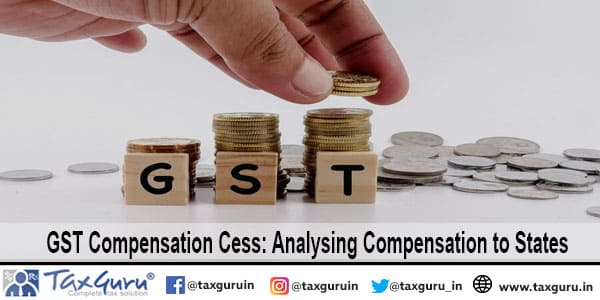Brought into force on 1st July 2017, the Goods and Service Tax (GST) is a comprehensive destination-based tax, enacted with the aim of merging the fragmented tax levy system and instead, bringing a unified tax levy system. Though it is a unified system of levying taxes, it is levied at both the central and state levels and intends to create a more simplified tax structure. The introduction of the GST regime, however, posed a problem to the states in the form of decline of revenue for certain states, especially those which relied on taxes from production/manufacture of goods. To solve this issue, the GST (Compensation to States) Act, 2017 was brought into force and the GST Compensation Cess was introduced to compensate the loss of these states.
The Compensation Cess was introduced to be levied for a period of five years from the introduction of GST, i.e., from 1st July 2017 to 30th June 2022. The GST Council was vested with the powers to alter this duration and to determine cess rates, exemptions and other components. However, the government has recently announced an extension of this period of levy till 31st March, 2026, though originally scheduled to conclude by 30th July 2022 to bridge the revenue gap. This extension was an effort of the government to provide continued financial assistance to the states which are still recovering from this revenue loss. To deal with this shortfall of revenue, the Budget 2023-2024 brought in an increase in rates of luxury and sin goods to generate additional revenue to fund this compensation. Though the Centre has paid the entire interim amount as compensation to the states, the present shortfall is attributable to the huge amount of loans taken during the COVID-19 Pandemic, due to which the funds in the GST Compensation Cess Fund became insufficient to meet the demand of the states.
The origin of this extension of time period can be traced back to the GST Council’s meeting on 29th June 2022, where about twelve states requested for an extension of compensation time period, with some of them requesting a revision in the distribution of GST revenue on the previous plea not being satisfied. These states expect a large deficit due to a widening of gap between the growth rate of income and a simultaneous increase in expenses, which they also state as one of the primary reasons for a decline in the revenue collection. The guaranteed growth rate for the states during the introduction of GST was 14%, but the widening of gap between the projected revenue receipts and the actual revenue receipts and the decrease in cess collection has diminished this rate of growth. Thus, the demands of the states have been fulfilled by the extension of time period to collect the cess and compensating the states through this amount. This compensation is funded by crediting the cess amount collected on certain specified products to the Compensation Fund and providing compensation to the states through this fund.
It was previously decided during the 49th GST Council Meeting that all pending GST dues for June 2022 would also be cleared immediately through the resources available with the Central Government and additionally, it would also be recuperated from the future compensation cess collections. This compensation cess was mandated to be collected by all taxpayers supplying a specific category of goods and services, except exporters and composition taxpayers, and includes certain imported goods as well, while exporters are allowed to claim refund of any such cess paid.

Another problem that had been persisting in the earlier compensatory framework is that the states which contributed the maximum through GST did not get compensation equalling their contribution. It had been widely argued that states, especially states involved in production, now earned less revenue when compared to the earnings during the VAT regime. The Finance Commission makes recommendations on the centre-state revenue sharing mechanism, tax administration and reforms related to expenditure, and in relation to this, the present recommendation till the Financial Year 2026 is to share with the states 41% of the Centre’s tax revenue. The tax contribution by each state acts as an indicator of the state’s development, as a state with higher growth and production has the ability to contribute more tax. However, this hasn’t been taken into consideration seriously while calculating the distribution of compensation to states. Tax contribution as a parameter to measure the efficiency of each state has been given very less to no priority over the years. The states, on the other hand, argued that though their contribution to the Central Tax Revenue has been higher than that of a few other states, they haven’t been receiving compensation in proportion to their contribution. This disparity in proportionate distribution of compensation has not yet been resolved fully even after the advent of GST and an appropriate measure for resolving this dispute is yet to be formulated. Also, as per Section 6 of the GST (Compensation to States) Act, 2017, the projected revenue and growth of any state for any particular year is calculated based on the base year revenue, which may be a wrong indicator as the state may have shown commendable development after the base year and it may not get reflected. Since the GST is a consumption-based tax, contribution by each state can be accurately estimated, which can be used as an efficiency indicator to give appropriate returns to each state in accordance with its contribution.
To conclude, the present extension of time period aims at compensating the states whose revenues were affected by the implementation of GST and further by the COVID-19 Pandemic, and from which such states struggle to come out. The Centre has also borrowed funds and distributed them to the states in line with the directives issued by the GST Council, thus making efforts to ease the burden of the states. The disproportionate compensation awarded leads to huge differences in the revenue received from the Centre between states. Furthermore, the present distribution by the centre is based more on population of each state than on contribution. A suggestion to ease this problem would be to include the tax contribution of each state as an indicator of its efficiency in production and progress and accordingly provide incentives and rewards to those states performing well, while simultaneously providing continued support for the development of states that are underperforming for their growth and progress as well. Also, the base year can be shifted forward to calculate the projected revenue as the present base year is too old and may not be a right indicator in many cases. Another method that can be considered is giving weightage to production and generation of revenue in each state and accordingly setting up different slabs of returns for different states based on their performances and revenue generation for the particular year. The Centre can also give higher compensation to states producing higher revenue as an incentive to their contribution and performances.



























